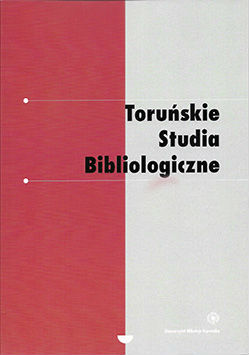Porównanie zasobu leksykalnego obu wydań Podręcznego słownika bibliotekarza na przykładzie słownictwa z zakresu prasoznawstwa
Comparison of the lexical resource of both editions of the Podręczny słownik bibliotekarza on the example of vocabulary in the field of press studies
Author(s): Katarzyna Jamrozik, Jakub Maciej ŁubockiSubject(s): Library and Information Science, Comparative Linguistics
Published by: Wydawnictwo Naukowe Uniwersytetu Mikołaja Kopernika
Keywords: Podręczny słownik bibliotekarza; press vocabulary; press; lexicographic world view
Summary/Abstract: Using the linguistic comparative method, the first (1955) and second edition (2011) of the Podręczny słownik bibliotekarza were checked for similarities and differences in the lexicographic world view of the press vocabulary. The analysis was preceded by an outline of the advantages and disadvantages of both editions. The analysis proceeded on three levels, which were of quantitative and qualitative character. The first level compared which of the entries appear in both editions, and which only in one. In this way, a list of 148 entries in the field of press was obtained (1955: 78 – 3.60% of all entries; 2011: 146 – 3.46%; 2011: 70 entries were added, 2 removed, and 5 non-press entries gained the press meaning). At the second level, the entries appearing in both editions (76 entries) were checked for formal similarities and differences (if the entry has literally the same shape (9) / literally the same content but in a different language shape (19) / entry has different shape of content and language (48)). At the third level, the last category of entries was checked, what was the essence of the changes: clarification of definition (12), extension of definition (10), increase (9) or decrease (2) the number of definition meanings, change in the meaning of definitions (3), change in meaning due to technological, social or ideological transformations (3), giving non-press definition the press meaning (5), replacing the enumeration of synonymous words with a full definition (2). The results of the analysis did not allow to draw general conclusions considering the trends in the development of press lexis/terminology: the majority of changes observed in the definitions did not result from their adaptation to the changes of the modern world, but from the elimination of errors and inaccuracies. It was also not gauged which part of the entries introduced for the first time in 2011 was caused by the development of the press studies and which part was caused by the removal of the omissions from 1955.
Journal: Toruńskie Studia Bibliologiczne
- Issue Year: 22/2019
- Issue No: 1
- Page Range: 67-91
- Page Count: 24
- Language: Polish

